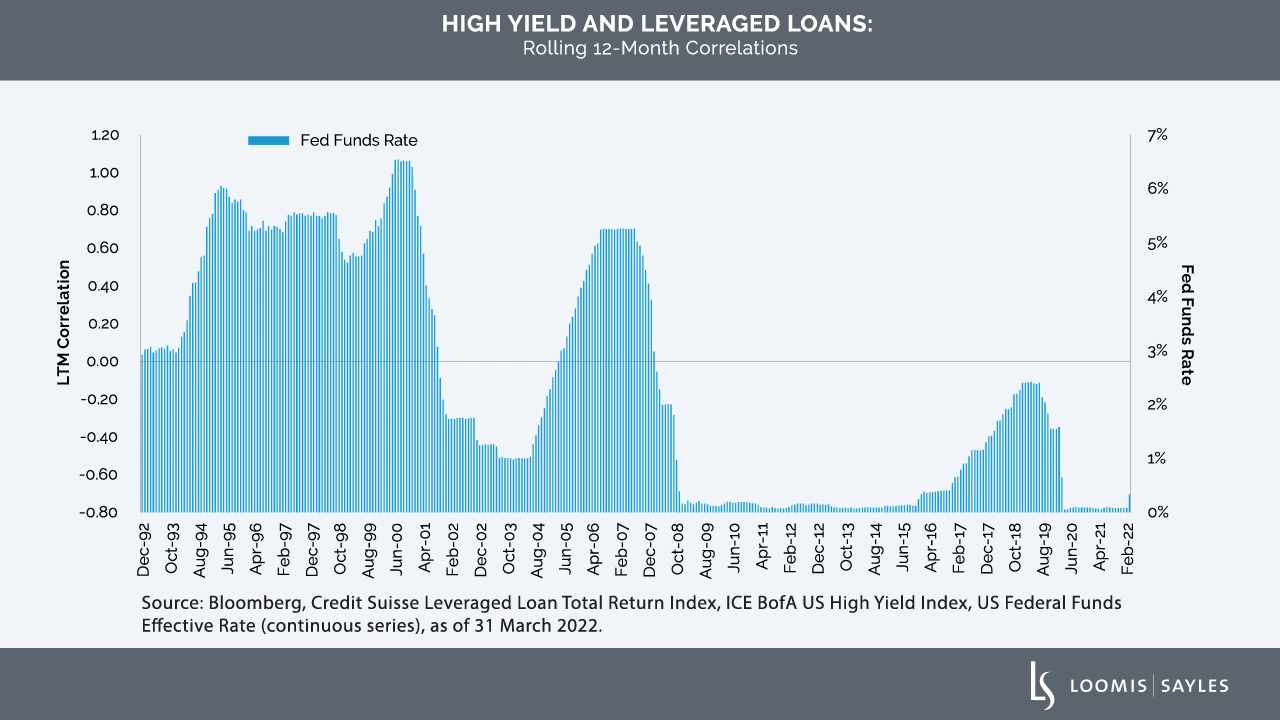Bank loans and high yield bond returns have been highly correlated for much of the past decade. But it wasn’t always that way. Before the global financial crisis (GFC), the asset classes were not strongly correlated—and signs of that decoupling have recently reemerged. It’s a significant shift, but one that’s in line with the asset classes’ characteristics and the typical market response to changing interest rates. Here, we’ll look at what drives the relationship between loans and high yield bonds, and why the recent shift matters for fixed income investors.
Understanding the Relationship
To better understand what drives the correlation between the two asset classes, we think it’s important to consider two key differences:
2. The coupon differential. High yield bonds have fixed coupons, while loans have floating coupons that adjust to rate changes. When interest rates rise, bond prices tend to drop to adjust for higher coupons available on newly issued fixed-rate bonds. Loan prices tend to remain relatively steady as their coupons float to match interest rate shifts.
These characteristics tend to influence market behavior and suggest that high yield and loan returns should not be highly correlated, particularly during periods of changing interest rates.
Fed Policy: A Game Changer for Correlations
The major shifts in Federal Reserve policy during the GFC changed the game for loan and high yield bond correlations. For roughly the first half of the loan market’s history, loan and high yield returns weren’t highly correlated. From the end of 1992 through the third quarter of 2007, the median 12-month correlation between the two asset classes was 0.45.[i] Then the GFC happened, and this figure changed to 0.82 between the fourth quarter of 2007 and the third quarter of 2021.[ii]

Federal Reserve intervention during the GFC was formidable. The Fed slashed the federal funds rate to nearly zero, and rates have remained very low since then. Investors struggled to earn adequate returns investing in short-duration bonds. Markets generally believed the Fed would step in should something go wrong, creating an incentive to take risk. With this backdrop, many risk assets became more highly correlated than usual; loans and high yield bonds were no exception.
As the Fed began to signal a new and potentially aggressive hiking cycle, the higher correlation between loans and high yield bonds began to break down. The decline began in March 2021, when the 12-month correlation between the two asset classes dropped to 0.79[iii] after a few years of nearly perfectly correlated returns.[iv] That decline accelerated in the fourth quarter of 2021, and it has remained below 0.50 since December 2021.
The prospect of imminent short-term rate hikes caused many investors to consider the impact of rising rates on the interest-rate-sensitive instruments in their fixed income portfolios. The longer the duration, the larger the potential price impact. The greater the expectation of rising rates, the more attractive floating-rate paper likely looked. This caused loan and high yield bond returns to diverge. Loans returned 0.38% over the past five months, while high yield bonds returned -3.70%.[v]
Why it matters
In our view, the value of loans as a credit diversifier is becoming more apparent as correlations between high yield bonds and loans break down. Investors became accustomed to treating loans and high yield as interchangeable asset classes during the prolonged period of low interest rates. We believe that thinking has shifted in the past few months. With the Fed set to continue raising rates, the complementary nature of the two asset classes is becoming more tangible thanks to the divergence of returns. Investors may be able to use loans to offset the greater credit and interest rate risk of high yield bonds while earning floating-rate income from senior, secured loans. We do not know how long this correlation relationship will persist, but it should remind investors of the beneficial diversification effect of adding loans to their credit allocations.
[i] Source: Credit Suisse Leveraged Loan Total Return Index, ICE BofA US High Yield Index; rolling 12-month correlations of monthly returns from December 1992 through September 2007.
[ii] Source: Credit Suisse Leveraged Loan Index, ICE BofA US High Yield Index; rolling 12-month correlations of monthly returns from October 2007 through September 2021.
[iii] Source: Credit Suisse Leveraged Loan Total Return Index, ICE BofA US High Yield Index; as of 31 March 2021.
[iv] Rolling 12-month correlations (rolling periods) of monthly returns from 30 April 2020 through 28 February 2021 showed nearly perfectly correlated returns (average 0.97).
[v] Source: Credit Suisse Leveraged Loan Index, ICE BofA US High Yield Index; returns for the five months ending 31 March 2022.
MALR02790
Market conditions are extremely fluid and change frequently.
This blog post is provided for informational purposes only and should not be construed as investment advice. Any opinions or forecasts contained herein reflect the
subjective judgments and assumptions of the authors only and do not necessarily reflect the views of Loomis, Sayles & Company, L.P. Information, including
that obtained from outside sources, is believed to be correct, but Loomis Sayles cannot guarantee its accuracy. This material cannot be copied, reproduced or
redistributed without authorization. This information is subject to change at any time without notice.




